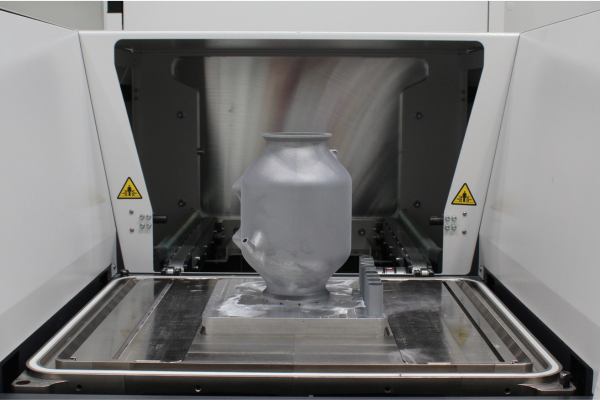While strides have been made over a relatively short period of time in additive manufactured heat exchange technology, there are still a number of obstacles that must be overcome to scale up to mass manufacture and production.
In this article, I focus on the challenges of heat exchangers and additive manufacturing (AM) – otherwise known as 3D printing – and how the technology can be improved to deliver on a mass scale. I’ll also share my experiences as Chief Product Officer at Conflux Technology about the importance of product strategy within a 3D applications company and my projections regarding the future of the industry.
What does innovation in AM heat exchangers look like?
The increasing potential for innovation by using additive manufacturing (AM) is a fact, and one that we’ve proven over and over again at Conflux with the likes of our annular and water charge air cooler (WCAC) designs.
Wavy metal cutaways, for example, have featured in many articles in recent years, and the vision of creating complex, monolithic parts — as well as a variety of channels, fins and complex surfaces — has contributed to their appeal. But innovation isn’t just about ‘inventing’ something. Innovation is also about adding value from new ideas.
It’s essential to mesh design for additive manufacturing (DfAM) at every point in the process, be extremely clear on the thermal and performance outcomes, and adapt the manufacturing process iteratively to accommodate the design and outcome. Innovation when designing for AM means knowing exactly what the machines are capable of, and then producing consistent results at the boundary of these capabilities.
Teams need to create a virtuous cycle of feedback, and work in a very agile and connected manner to come up with designs that not only test the machines to their capacity but feed data on their success or failure, as well as simulations, back to the designers in real-time.
A big challenge for additive manufacturing (AM) heat exchangers is delivering performance to drive value. Many beautiful and organic parts mix fluids well, but they tend to heavily disrupt flow, causing massive pressure drops – an undesirable outcome. Removing the remaining powder from these pieces may also be an obstacle to success.
At Conflux, we've been developing heat exchangers where we print different surfaces to suit each fluid that flows through the unit. We vary structures within the channels to accommodate the changing properties of different fluids as they heat and cool. We also design for powder removal and have honed the process and design to great effect.
Conflux ‘cartridge’ heat exchanger
The Conflux ‘cartridge’ heat exchanger is an example of the partnership between innovation adding value.
The concept behind the cartridge design is to embed an additively manufactured core into a larger system — a traditionally manufactured casing, or an integral part of another component like a gearbox housing — with the heat exchange taking place close to the source of heat, simplifying the overall system.
The additively manufactured component can incorporate the radical performance benefits of AM, be easily accessed for servicing or replacement and compete on cost with similar technologies.
In simpler terms, in use cases where access is a key issue, it means you can access the part of the heat exchange unit that gets dirty, pull it out and replace it. A continuous process with several units in parallel can avoid any shutdown for maintenance and save a lot in costs.
Want to know more about the Conflux ‘cartridge’ heat exchanger?
Read the full case study.
How do 3D applications work into product strategy?
Having a functional design process in place isn’t the only element that needs to be refined in order to ensure maximum output from an AM heat exchanger. Having an effective product strategy is also paramount.
Conflux Technology began life with several insights around using additive manufacturing to do things that no one was doing at the time – developing working 3D printed heat exchangers.
Working with our customers in aviation, motorsport and energy, we learnt a lot, and used those insights to develop a number of heat exchanger core designs that we were able to apply to an increasing number of thermal problems; particularly in industries that are currently scaling up, such as green energy, electric vehicles, batteries and computing power — all of which involve tremendous amounts of heat generation.
We saw that by bringing together innovations in engineering design and additive manufacturing technology, there was an opportunity to create lightweight thermal applications with game-changing performance. Most importantly, however, we learnt how to print thin-walled, complex structures that hold pressure – the peak challenge for AM heat exchangers.
Conflux is now entering a new phase of its organisational development. Heat exchange might seem narrow but every industry has a need for it. Accordingly, we're challenging ourselves to scale our know-how into applications that can proactively address market needs with all the benefits of AM: radical performance, rapid prototyping, customised products and distributed manufacturing.
The design freedoms afforded by 3D printing are vast. From a product perspective, our aim is to perfect a balance between developing specific applications, and broader categories that can inspire new and innovative products.
It's time now, to bring forward a number of broader applications and make our bespoke heat exchange development more efficient and accessible to the customers who’ll get the biggest benefits, and deliver value to these customers.
The question is: bespoke or configured products?
Every customer is different. Accordingly, completing a discovery process to understand the boundary conditions and other requirements of each customer’s heat exchange problems is a very important first step that cannot be underestimated. That said, our belief that innovation is about adding value means the choice between using a bespoke or configured product doesn’t need to be a zero-sum game decision for customers.
When we work on a bespoke project, we select the appropriate core design and build it into a heat exchanger, altering features of the internal geometry to suit the specific fluids and conditions, then developing the large-scale structures and packaging. When it comes to configured products, however, we define the packaging around a parameterised core geometry.
We've created tools and models that allow us to scale the design within those parameters, giving all the benefits of the fluid-matched geometry in a far shorter development time — we can calculate exactly what size of heat exchanger is required, and arrive at the first sizing to use with hours and not days of effort.
Of course, at this point there’s still some engineering work to be done — we now need to render that into something that can be printed — but because we've already put the work into the design, it saves significant time. And every single hour that’s saved in design is one that a customer doesn't need to pay for.
So, how do we overcome mass-scale production, standards and quality control challenges?
Scaling AM into mass production technology is where the major challenge lies. Two of the clearest and present obstacles we face are the costs of production and developing industry-wide accreditation/certifications/standards.
The price of AM machines is often the biggest cost associated with printing parts, followed by the post-processing costs. So, lowering machine costs or increasing speeds is vital. In the interim, the focus at Conflux has been to be more competitive and cost-effective by printing smaller parts focusing on high value heat exchange that take less time to print than 3D printing the housing.
Another challenge to scaling is having a robust industry standard certification, verification and testing processes. At the moment, industry acceptance of standards for AM certification are murky. Conflux wants to contribute to clarity around this issue. As well as commencing AS9100D certification, we’ve brought on Andrew Milner, a registered aerospace auditor and thought leader, to drive our quality management.
There are several companies focusing on making radical changes to the speed of printing, and we watch this space with great interest.
Where to from here?
I believe, in 3D printing in general, there will be some broad technological shifts in the next five years. The advances that are happening in healthcare and its associated fields, as well as engineering and manufacture, will have enormous impacts on society.
Over the course of the next five years, I’m also confident we’ll see the promise of AM delivered, as increases in capacity and capability will drive affordability and prevalence of parts in production. Maturing business models amongst service bureaus and applications companies alike drive the evolution of distributed manufacturing.
Intellectual property protection capabilities are commercialising. Companies like ours will safely print our parts anywhere in the world, and an increased ability to print to scale will be a paradigm shift. Materials investigation and research will no doubt yield interesting things that we can build – new materials, new coatings, new applications, new surprises that will help us as well.
I believe additive manufacturing has a bright future and I specifically think that metal additive manufacturing will develop into the dominant mechanism in which new top-end heat exchange will be delivered.






